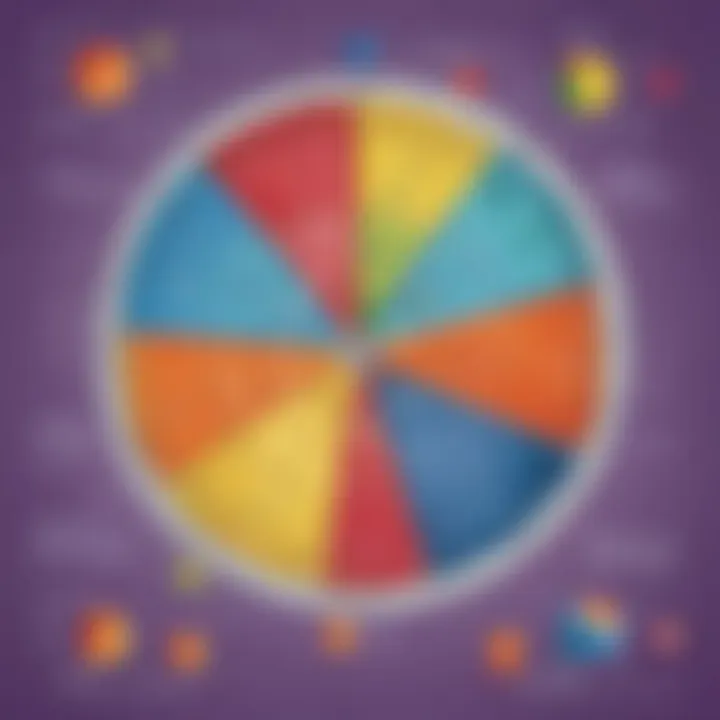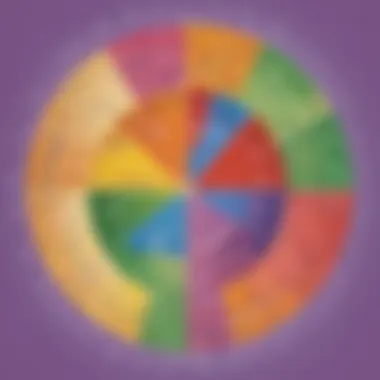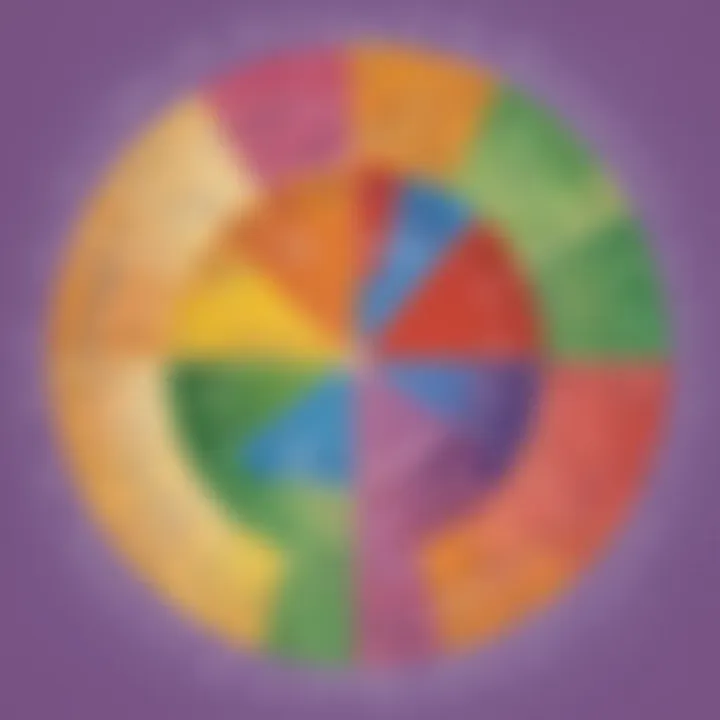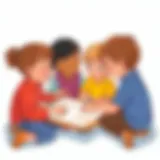Mastering the Multiplication of Simple Fractions


Intro
Multiplying simple fractions is a vital mathematical operation that often forms the foundation for more complex concepts. Understanding this process can be instrumental for students, teachers, and parents alike. Mastery of multiplying fractions opens the door to various mathematical applications. In this guide, we will walk through the steps necessary to multiply fractions effectively, highlighting key principles and common pitfalls.
This guide targets learners of all ages, from elementary school students grappling with their first exposure to fractions, to educators looking for clarity in teaching this subject. The importance of grasping the multiplication of fractions cannot be understated, as it lays the groundwork for subsequent topics in both arithmetic and geometry.
Interactive Learning Games
Incorporating games into the learning process can significantly enhance children's understanding of multiplying fractions. Engaging and educational games provide students with fun ways to practice and reinforce their skills. Here, we explore some of the most popular educational games that focus on fractions.
Popular Games
- Math Bingo
A classic game that can be tailored to focus on fractions. - Fraction Frenzy
An interactive online game that allows users to practice fraction operations in a time-restricted setting. - Pizza Fraction
This game introduces fraction multiplication through the concept of sharing pizza slices among friends.
Description of Top Educational Games
Each game offers unique mechanics and educational benefits. For example, Math Bingo helps students recognize fractions visually, while Fraction Frenzy emphasizes speed and accuracy. Pizza Fraction builds real-life context, allowing learners to conceptualize fractions in a relatable way.
Benefits of Playing Educational Games for Kids' Cognitive Development
Playing educational games can promote cognitive skills such as critical thinking, memory retention, and problem-solving. These games can also cultivate motivation and enthusiasm for learning, making complex subjects like fractions feel accessible.
"Interactive games aid in translating abstract mathematical principles into comprehensible tasks for children."
Game Reviews
Math Bingo
This game encourages participation and can be easily modified to suit different learners' levels. Players recognize fractions among a grid of different fractions, which reinforces their understanding.
Fraction Frenzy
A fast-paced challenge where players solve fraction multiplication problems against the clock. This game effectively builds confidence while allowing students to practice.
Pizza Fraction
This group activity involves dividing a pizza into various fractions and encourages teamwork. It gives students a practical application of fractions through sharing, bringing a social element to math practices.
Comparison of Gameplay and Learning Outcomes
While all these games serve to improve students' skills, their approaches vary. Math Bingo fosters a collaborative environment, whereas Fraction Frenzy promotes individual skill enhancement. Pizza Fraction organizes learning around social interaction, making it an excellent choice for group settings.
By exploring these interactive learning games, both educators and parents can facilitate a deeper understanding of how to multiply simple fractions in enjoyable ways. This reiterates the importance of integrating play into education, especially in foundational subjects such as mathematics.
Tips and Tricks
To support children's learning journeys, here are some practical tips for parents and educators.
- Create a Routine: Establish a consistent time for practicing multiplication of fractions.
- Use Visual Aids: Diagrams or physical items can help students visualize fractions better.
- Encourage Questions: Motivate children to ask why certain methods work.
- Incorporate Real-Life Examples: Utilize everyday scenarios to apply fraction multiplication.
These strategies can make the teaching and learning experience rewarding and effective. With a structured approach, students can master multiplying fractions and build a strong mathematical foundation.
Understanding Fractions
Understanding fractions is essential for mastering basic math skills, especially when it comes to multiplication. This knowledge lays the foundation for more complex mathematical concepts. Knowing fractions enables learners to compare numbers, solve problems, and understand various mathematical relationships. The concept of fractions represents parts of a whole, making it universal across different fields like science, economics, and social studies. This section introduces key elements that will enhance comprehension and application of fraction multiplication.
Definition of a Fraction
A fraction is a way to express a number that is not whole. It is written in the form of one integer over another, separated by a line, for example, 1/2. The number above the line is called the numerator and indicates how many parts are taken. The number below is the denominator, showing how many equal parts make up a whole. Understanding this basic definition helps in grasping the operations involving fractions, particularly multiplication.
Components of a Fraction
Fractions have two primary components: the numerator and the denominator. Each plays a vital role in conveying the complete meaning of fractions, especially when multiplying them.
Numerator
The numerator is the part of the fraction that indicates the number of equal parts being considered. For instance, in the fraction 3/4, the numerator is 3, showing that three parts are being taken from a whole divided into four parts. The numerator's significance lies in defining a specific quantity within the division of the whole. This aspect is central to understanding multiplication, as you will often multiply numerators when dealing with multiple fractions. A key characteristic of the numerator is that it can be any whole number, which makes it versatile for different types of calculations.
Denominator


The denominator, the bottom part of a fraction, signifies how many equal parts the whole is divided into. In 3/4, the denominator is 4, meaning the whole is divided into four equal sections. Grasping the concept of the denominator is crucial in fraction multiplication. It defines the scale and size of each fractional part. A unique feature of the denominator is that it cannot be zero, as division by zero is undefined, which can lead to significant errors in calculations. Understanding this aspect helps in avoiding common pitfalls when manipulating fractions.
Types of Fractions
Fractions can be categorized into different types, including proper fractions, improper fractions, and mixed numbers. Each type has distinct characteristics and is useful in various mathematical scenarios.
Proper Fractions
Proper fractions have numerators smaller than their denominators, such as 2/5. This type is particularly useful when expressing quantities that are less than one whole. Proper fractions are beneficial because they offer simple visual representations of parts of a whole, making them easier for learners to grasp. However, they might limit the representation of values greater than one, which is where improper fractions come into play.
Improper Fractions
Improper fractions, on the other hand, have numerators that are equal to or larger than their denominators, such as 5/4. These fractions can sometimes be more complex but are essential for representing values greater than one. A key characteristic of improper fractions is their ability to convey larger quantities efficiently. However, they can be harder for beginners to understand without converting them into mixed numbers, which could be seen as a disadvantage for some learners.
Mixed Numbers
Mixed numbers combine a whole number and a proper fraction, like 1 3/4. This representation can be helpful in everyday situations where whole items are being combined with partial ones. The advantage of using mixed numbers is that they often feel more intuitive, especially for real-life applications like cooking or measuring. However, learners need to understand conversions between mixed numbers and improper fractions to manipulate them correctly in multiplication.
In summary, understanding fractions, their components, and types is essential for effectively learning and applying the multiplication of simple fractions. This knowledge paves the way for mastering more advanced mathematical topics.
The Concept of Multiplication
Multiplication serves as a cornerstone in mathematics. It goes beyond mere addition of numbers. When one multiplies, they are essentially finding the total of groups. This operation offers a streamlined method to handle larger numbers without complex calculations. In this guide, we emphasize understanding multiplication because it directly impacts the process of multiplying fractions, making it easier to grasp advanced mathematics.
Understanding Multiplication
Definition
Multiplication is defined as repeated addition. To put it simply, if you have a number times another number, you can think of it as adding the first number multiple times. A significant characteristic of multiplication is its ability to simplify calculations. This aspect is particularly useful in both theoretical and practical applications of mathematics.
One unique feature is the commutative property. It states that changing the order of numbers does not affect the product. This property is a benefit; it allows flexibility in calculations. However, one disadvantage is that it may lead to confusion when first learning.
Purpose
The purpose of multiplication is to make numerical calculations more efficient. It transforms the process of combining quantities into manageable segments. With this operation, learners can quickly evaluate larger mathematical problems. It is beneficial for developing further mathematical concepts and reinforces foundational skills necessary for algebra.
A unique feature of multiplication is its scalability. This means learners can apply it across different number sets, be it integers, fractions, or decimals. However, challenges can arise when transitioning from whole numbers to fractions, as some find it difficult to grasp.
Multiplication in Mathematics
Real-Life Applications
Multiplication is not just confined to textbooks; it has many real-life applications. From calculating expenses to determining quantities in cooking, it helps streamline daily tasks. A key characteristic of real-life applications is their relatability to everyday challenges. Students who see practical uses of multiplication tend to engage more with the topic.
A unique feature of these applications is their diversity. Whether it’s budgeting, shopping, or construction, each scenario necessitates the use of multiplication. The advantage is clear: understanding multiplication enhances practical problem-solving skills. Yet, without this understanding, many may struggle with real-world mathematical tasks.
Role in Algebra
In algebra, multiplication is fundamental. It serves as a vital tool in manipulating equations and understanding functions. One key characteristic is its integrative role in algebraic expressions. When students solve equations, they often multiply to isolate variables. This makes multiplication an essential component of higher mathematics.
The unique feature here is its ability to combine with other operations. Learners can mix multiplication with addition or subtraction to form complex expressions. While such versatility is an advantage, it does pose challenges as students may find it difficult to coordinate multiple operations without a firm grasp of multiplication itself.
Step-by-Step Guide to Multiplying Simple Fractions
Multiplying simple fractions is a fundamental skill in mathematics. This section provides a structured and detailed exploration of how to approach this task. Understanding this process is important not only in academic settings but also in real-world applications. The steps outlined here will guide learners through the multiplication of fractions, ensuring they grasp each component clearly.
Identifying Fractions to Multiply
The first step is to identify the fractions that need to be multiplied. Each fraction consists of a numerator and a denominator, both important to the multiplication process. To multiply two simple fractions, the fractions must be clearly defined. For example, if you are asked to multiply one-half by three-quarters, each fraction must be noted as it stands. Always ensure the fractions are in their simplest forms before proceeding to multiplication.
Multiplying the Numerators
Next, focus on the multiplication of the numerators. The numerator is the top part of the fraction. When multiplying two fractions, multiply these numerators together. For instance, from the earlier example of one-half and three-quarters, multiply 1 (the numerator of one-half) by 3 (the numerator of three-quarters). This step yields the new numerator for the result. Thus, you get 1 × 3 = 3. The product of the numerators becomes the numerator of the resulting fraction.
Multiplying the Denominators
After calculating the numerators, move on to the denominators. The denominator is the bottom part of the fraction. Simply multiply the denominators of both fractions in the same manner. Continuing from the previous example, multiply 2 (the denominator of one-half) by 4 (the denominator of three-quarters). Therefore, 2 × 4 = 8 gives you the new denominator for your resulting fraction.
Forming the Resulting Fraction


Now, form the resulting fraction using the products from the previous steps. Your resulting fraction consists of the newly calculated numerator and denominator. In the example of one-half and three-quarters, the multiplication yields a fraction of 3 over 8, or 3/8. This fraction represents the multiplication of the original fractions.
Simplifying the Resulting Fraction
Finally, check if the resulting fraction can be simplified. Simplifying means reducing the fraction to its simplest form, where the numerator and denominator have no common factors other than one. In the case of 3/8, there are no common factors, since 3 is a prime number and does not share any factors with 8. Thus, the fraction remains as 3/8. Always remember that simplification is an important part of fraction multiplication as it provides clarity and ease of understanding.
Key Point: Always check both fractions for simplification before and after performing multiplication.
In sum, following these systematic steps will facilitate a clear understanding of how to multiply simple fractions. Emphasizing these processes provides students with a sturdy foundation in fractional multiplication, reinforcing both mathematical skills and confidence in handling numbers.
Examples of Multiplying Simple Fractions
Understanding how to multiply simple fractions is a fundamental skill in mathematics. This section provides concrete examples to illustrate the process clearly. By going through real situations, learners can grasp not just the how, but also the why behind the multiplication of fractions. These examples emphasize the ability to apply theoretical knowledge in practical scenarios, enhancing overall comprehension and retention of the concept.
Example One
Let’s begin with the fraction multiplication of 1/2 and 3/4. Here’s how to do it step-by-step:
- Identify the fractions: We have 1/2 and 3/4.
- Multiply the numerators: Multiply the top numbers: 1 * 3 = 3.
- Multiply the denominators: Multiply the bottom numbers: 2 * 4 = 8.
- Form the resulting fraction: Place the product of the numerators over the product of the denominators: 3/8.
Thus, 1/2 multiplied by 3/4 equals 3/8. This simple example shows the straightforward nature of fraction multiplication. The result is crucial as it conveys how much of a whole is represented by the given fractions.
Example Two
Now let's look at another example involving 2/3 and 5/6:
- Identify the fractions: We have 2/3 and 5/6.
- Multiply the numerators: Multiply the top numbers: 2 * 5 = 10.
- Multiply the denominators: Multiply the bottom numbers: 3 * 6 = 18.
- Form the resulting fraction: Place the product of the numerators over the product of the denominators: 10/18.
- Simplify if needed: Both numerator and denominator can be divided by 2, leading to 5/9.
Therefore, 2/3 multiplied by 5/6 gives us 5/9 after simplification. This example is beneficial to understand how to simplify fractions once the multiplication is executed.
Example Three
Lastly, consider the fractions 3/5 and 2/3:
- Identify the fractions: We have 3/5 and 2/3.
- Multiply the numerators: Multiply the top numbers: 3 * 2 = 6.
- Multiply the denominators: Multiply the bottom numbers: 5 * 3 = 15.
- Form the resulting fraction: Place the product of the numerators over the product of the denominators: 6/15.
- Simplify: Both parts can be divided by 3, resulting in 2/5.
Thus, multiplying 3/5 with 2/3 leads to 2/5 after simplification. This example reiterates the importance of simplification, showcasing clearly that even after multiplying properly, the end result can be presented in a more convenient form.
Understanding these examples highlights that fraction multiplication is not only about numbers but applying a methodical approach to find a solution.
In summary, learning through practical examples is essential for grasping the concept of multiplying simple fractions. Enabling learners to visualize the process helps cement the knowledge necessary for tackling more complex mathematical operations in the future.
Common Mistakes in Multiplying Fractions
Understanding how to multiply simple fractions is essential for mastering mathematical concepts. However, many learners encounter hurdles along the way. Addressing these common mistakes can significantly enhance comprehension and prevent errors in calculations. By identifying pitfalls, one can adopt strategies to avoid them, thus making the learning process smoother and more effective. Recognizing these mistakes aids both educators and students, ensuring a more robust grasp of fraction multiplication.
Ignoring Simplification
One of the most frequent mistakes is ignoring simplification. After multiplying fractions, some may forget to simplify the resulting fraction. Simplification not only provides clarity but also often presents the answer in its most understandable form. For example, if one multiplies 2/4 and 3/6, the product is 6/24. Many may stop there, failing to notice that 6/24 can be reduced to 1/4. Simplifying improves the quality of answers and ensures they are easily interpretable.
To avoid this mistake, always check if the resulting fraction can be simplified. Use the greatest common divisor (GCD) for simplifying. Here are key points to remember about simplification:
- Always look for common factors between the numerator and denominator after multiplying.
- If unsure, list the factors of both numbers to find the GCD.
- Practicing simplification regularly can strengthen skills in this area.
Incorrect Multiplication of Numerators and Denominators
Another common error occurs in the multiplication of numerators and denominators. Some learners incorrectly multiply fractions due to lack of attention or understanding. It is vital to remember that when multiplying fractions, the numerator of the first fraction multiplies with the numerator of the second, and similarly for the denominators.
For instance, when multiplying 1/3 by 2/5, the correct procedure is: multiply 1 by 2 to get 2 for the new numerator, and multiply 3 by 5 to find the new denominator, resulting in 2/15. Errors often arise when learners mix up this process, resulting in faulty products like 1/5 instead.
To overcome this issue, practice consistently. Here are strategies to assist:
- Write out each multiplication step clearly to avoid confusion.
- Use visual aids like fraction bars or diagrams to conceptualize operations.
- Engage in exercises that reinforce the correct procedure, focusing on clear distinctions between numerators and denominators.
By understanding and addressing these common mistakes, students can approach multiplication of fractions with more confidence and accuracy.
Real-World Applications of Fraction Multiplication
Understanding how to multiply simple fractions is not just an academic exercise. It has significance in various real-world situations. The ability to work accurately with fractions can yield practical advantages in everyday tasks. This section will explore two key areas: cooking and recipes, and construction and measurement.


Cooking and Recipes
In the kitchen, precise measurements are essential. Many times, recipes need modification. You might want to double a recipe for a gathering or half it for a small family meal. This requires multiplying fractions efficiently.
Imagine a recipe that calls for (\frac23) cup of sugar. If you want to double the recipe, you need to multiply (\frac23) by 2. The math is straightforward:
[ 2 \times \frac23 = \frac43 \text cups of sugar ]
This result represents one and one-third cups of sugar. Without knowing how to multiply fractions, such alterations could lead to inconsistent results in taste or texture.
Moreover, when dividing ingredients between multiple servings, fractions become crucial. Cooking often involves modifying quantities with fractions. A firm grasp of fraction multiplication ensures that you can adapt recipes successfully for any occasion.
Construction and Measurement
Fraction multiplication is equally important in construction and measurement. Many construction projects require precise calculations. Consider a scenario where a contractor needs to calculate the area for flooring. If the space measures (\frac34) of a meter in width and (\frac25) of a meter in length, the calculation of the area involves multiplying these fractions.
[ \textArea = \frac34 \times \frac25 ]
The result gives the area as (\frac620), which simplifies to (\frac310 \text square meters ). Here, understanding how to multiply fractions allows for accurate material estimation, avoiding excess waste or shortages.
Furthermore, fractions are often found in blueprints. They assist in converting linear measurements into square footage, which is essential for planning. Not being able to multiply fractions can lead to significant errors with serious financial consequences.
Mastering fraction multiplication opens doors to better planning, ensuring safety and precision in various fields.
In these ways, the applications of fraction multiplication stretch beyond the classroom and impact daily activities in cooking and construction.
By recognizing these real-world implications, one can appreciate the importance of the concepts of fraction multiplication more deeply.
Educational Tools for Learning Fraction Multiplication
Understanding how to multiply fractions can be challenging for many learners. However, using appropriate educational tools can significantly enhance this learning process. These tools not only reinforce concepts but also provide a platform for students to practice their skills effectively. Engagement through various methods helps students grasp the underlying principles and apply them with confidence in real-world situations.
Educational tools can be divided into several categories, each with distinct benefits. They cater to different learning styles, ensuring that all students can find a method or resource that resonates with them. Some tools allow for visual learning, while others encourage kinesthetic or auditory approaches.
"The right educational tools can transform the way students understand fractions, making complex concepts more accessible."
Interactive Games
Interactive games provide a dynamic way for learners to practice multiplying fractions. These games often incorporate elements of competition and achievement, motivating students to engage more deeply with the subject matter. Many online platforms offer fraction games catering to various age groups and skill levels, allowing for personalized learning experiences.
For example, games that allow students to earn points or rewards by solving fraction multiplication problems can make the learning process enjoyable. They often include fun themes and characters which can capture the attention of young learners. Additionally, feedback provided during gameplay helps students identify areas of improvement instantly.
- Some popular platforms for interactive fraction games include:
- ABCya
- Math Playground
- Coolmath Games
These sites provide intuitive frameworks that simplify learning complex topics. By integrating gamification into education, students are more inclined to practice and, consequently, improve their understanding of multiplying fractions.
Worksheets and Online Resources
Worksheets and online resources serve as essential tools for practicing multiplication of fractions. They provide structured exercises that help solidify understanding through repetition. Worksheets can be tailored to different proficiency levels, offering simpler problems for beginners and more complex scenarios for advanced learners.
Many educators and parents can find printable worksheets online, which can be easily distributed among students. The importance of gradual progression in difficulty can’t be overstated. It allows learners to build on their knowledge without feeling overwhelmed.
There are also several websites that offer online resources, including video tutorials and interactive exercises, making fraction multiplication more approachable. Some notable resources include
- Khan Academy
- IXL
- Purplemath
These platforms not only host a wealth of information but also provide lasting reference materials as students progress in their understanding. The combination of worksheets and online tools offers a comprehensive approach to mastering fraction multiplication.
In essence, educational tools for learning fraction multiplication are vitally important. By providing a variety of interactive and structured resources, educators can cater to diverse learning styles and enhance the mathematical skills of learners.
Ending
In concluding this comprehensive guide on multiplying simple fractions, it is essential to recognize the significance of mastering this skill. Multiplying fractions is not just an isolated mathematical operation; it forms a critical part of broader mathematical understanding. Students who grasp the principles of fraction multiplication build a solid foundation for tackling more complex mathematical concepts.
One key benefit of learning to multiply fractions is the practical application it holds in daily life, whether in cooking, crafting, or even financial calculations. Understanding how to manipulate fractions enables individuals to navigate tasks that involve measurements or ratios with ease.
Moreover, recognizing common pitfalls, such as neglecting to simplify results, allows students and learners to avoid mistakes that could hinder their problem-solving abilities. This guide has equipped readers with the necessary tools and knowledge to multiply fractions accurately, which can bolster confidence in their overall mathematical skills.
In summary, proficiency in fraction multiplication not only enhances mathematical aptitude but also empowers learners to apply their skills in real-world contexts. As we've explored throughout this article, the journey of understanding fractions starts here and can lead to a more profound appreciation of mathematics as a whole.
Summary of Key Points
- Fundamental Skills: The ability to multiply fractions provides essential skills for tackling more advanced math topics.
- Practical Applications: From recipes to building projects, the ability to multiply fractions is widely beneficial.
- Common Mistakes: Awareness of frequent errors can help learners avoid pitfalls and improve accuracy.
- Educational Tools: Utilizing interactive resources can reinforce learning and make the process enjoyable.
- Confidence Building: Mastering this subject bolsters confidence and encourages further exploration in mathematics.















